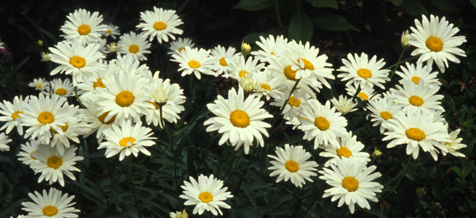
|
| Daisies |
| Being in love is surely one of life's most blissful feelings. It lightens one's cares if it doesn't make them disappear, it improves the appetite, increases goodwill and whatnot. Who would argue? We should be in love more often, not less. Seattle is my hometown, and for half my life I've been madly in love with its plants. What started as just another diversion has become my livelihood. My job in this new weekly column is to share with you an infinite joy and fascination with Seattle greenery. Immersing myself in our living city, the silent songs of growing plants, the wonders of nature --in turn I give these marvels voice, to you. You may not be a gardener, may not be any more interested in plants and nature than I used to be. It doesn't matter: regardless who you are and what your passion is, if you were to walk with me, touring Seattle's plants and natural history, I'd wager to win you over. There's no resisting nature's rhythm and beauty; it's in our genes. And I shall freely disclose neat glimpses to inspire or delight you, since my very role in society is to turn-on people to nature, especially plant life. Just like being in love, interaction with greenery is a healing, invigorating influence. At the same time it sharpens our senses, it calms our nerves. What a deal. |
| This week, if I had to focus on just one plant for "show and tell," it would be daisies. Yes, I know, the rose is far more romantic, not to mention sweet, but its heartless thorns always interfere with my affection. Daisies are glorious right now, loving our wet spring, rejoicing in the summer sun, gleaming white along the roadsides, carpeting moist lawns, nodding in floral borders. The name derives from day's eye. Three species commonly are seen. The ubiquitous LAWN DAISY (Bellis perennis) is a cute little dwarf with penny-sized flowers; it has been blooming for months. The daisy of vacant lots, meadowy places and roadsides, a foot or two tall, with flowers an inch or two wide, is the "love me -- love me not" daisy. It is the OX-EYE daisy, and scientists call it variously Leucanthemum vulgare or Chrysanthemum Leucanthemum. The robust and buxom SHASTA DAISIES (Leucanthemum x superbum)or (Chrysanthemum x maximum) of gardens are latest to bloom and the most luscious to behold. All of these flowers and their leaves are edible, raw or cooked. Try them; you'll be glad you did. Add some to salads. Or make a wreath of them to crown someone you love. None of these three daisy species are natives to Seattle, but all thrive here, and two are fully naturalized. We don't have native daisies, though do have some asters and other cousins. As the year goes on you may read about them. |
| Shakespeare had a soothsayer humbly observe "In nature's infinite book of secrecy, a little I can read." Well, in my "reading," I hope, you'll be encouraged, uplifted, stimulated, and in a word --benefited. Seattle may or may not be your favorite big city. The Weekly itself may elicit mixed smiles and growls from you. But since we live here, and read this, let's do the best we can. Nature is omnipresent, not only impossible to ignore, being the very basis for existence, but is often the delight of our lives. Welcome it. Reach out to it. |
I am grateful for this opportunity to share. Like a host who has prepared a lovely meal, but needs guests to relish it, so a writer needs readers. June is the most floriferous month of the year, with the longest days, so it is perfect now to begin exploring our living city. Go taste some daisies. All three vary in flavor, and you can find your favorite.
(originally published in The Seattle Weekly, June 1996)
Back |
|
|

